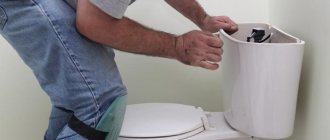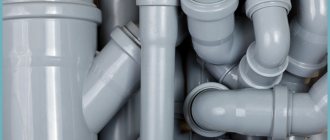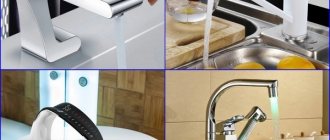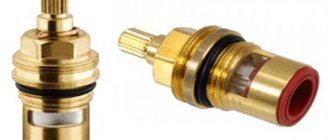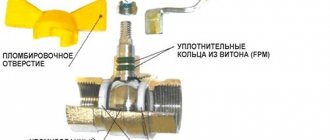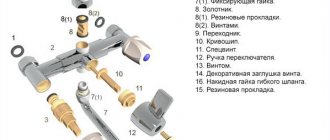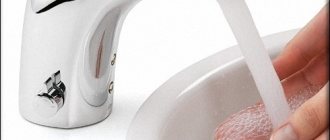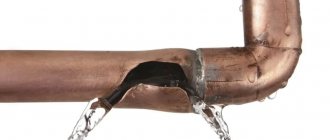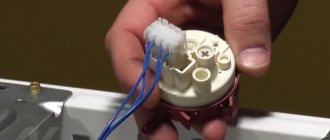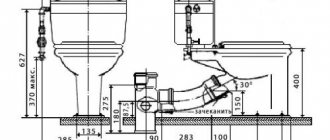Due to excessive load, poor quality of tap water and “makeshift” installation, plumbing fixtures and products tend to fail sooner or later. Some breakdowns appear immediately clearly and openly, for example, through leaks. Other faults may not manifest themselves for a long time or may cause only slight discomfort when using plumbing fixtures.
When the faucet in the bathroom is humming, many homeowners do not pay enough attention to this problem, considering it just an annoying inconvenience that can be tolerated. However, this defect in the plumbing system cannot be left to chance, as it can be a signal of much bigger troubles.
Diagnosis of the problem
Many homeowners have encountered the problem of a humming faucet. Moreover, this fate will not escape either the owners of old “Khrushchev” buildings or the happy owners of brand new apartments with an improved layout. At first, the noise, hum and whistle inside the pipes only brings inconvenience, as it irritates the residents or wakes up sleeping household members at the wrong time.
Over time, homeowners become so accustomed to the constant sound effects that they stop noticing them. However, such a “musical” water supply can subsequently cause a serious accident, so noise from the pipes must be dealt with.
In the first stages, it is important to understand where the noise is coming from in order to understand how to solve this problem. To identify the cause of the hum, you need to alternately turn on cold and hot water in the sink or bathtub; it is more convenient to do this when there is complete silence at home.
To determine the malfunction, you need to find out not only the location of the hum, but also determine the moment when it appears: when opening and closing the tap or at the moment when water is simply flowing. Also, when diagnosing a problem, it is useful to determine whether there is vibration in the pipes and its intensity.
Note! Sometimes the noise from the tap is so loud that it can be heard even from the entrance. And sometimes, on the contrary, it is so weak that it is barely noticeable only when it is absolutely quiet. As a rule, this phenomenon, regardless of the volume, indicates a malfunction of the plumbing system, so it must be dealt with.
Why is the valve type tap knocking?
Two-valve faucet models are still widespread. If a hot water faucet of this type makes noise, then the cause is a malfunction of the axlebox faucet. Valve structures have separate axle-box taps for cold and hot water, on which ceramic or rubber gaskets are installed. It is the mechanical wear of these gaskets that causes noise and rattling.
To repair a valve mixer, you need to find out which gasket is in the axle box. Technically, it looks like this: you turn the valve and count the revolutions. If less than one is needed, then the faucet is equipped with an axle box with a ceramic gasket. And if more than two turns are needed, use a rubber one. Then everything is easy and simple, if you need to replace the rubber gasket. Replacing the ceramic gasket is a more troublesome task, since you will have to tinker with the silicone insert under the gasket.
Possible reasons
When understanding why the faucet in the bathroom is humming, it is necessary to accurately identify the cause of the malfunction so that repair work can help solve this problem. After all, measures that are effective for one reason may not produce results if another breakdown is the root of the problem. Most often, the faucet makes extraneous sounds due to the following defects:
- Because of old pipes. If the house is old, dating back to Soviet times, and major repairs of the water supply system have not been carried out, the pipes will decrease in diameter over time due to the accumulation of rust and salts on their inner walls. Since the pipe becomes narrower, but the water pressure remains the same, vibrations, rattling and loud noise occur in the water supply.
Old pipes - Immediately after major renovation. Many management companies are starting to overhaul the plumbing system of old houses. However, their residents notice that the water in the tap does not stop humming. This happens because the pipe connections are poorly made or the pipes run too close to each other and are not insulated.
- Due to high pressure in the water supply system. If the pressure inside the pipes increases, noise, whistling and rattling appear in the tap. Most often, these phenomena appear when opening or closing a tap.
- Due to a malfunction of the mixer shut-off valves. If the noise is localized only in one apartment, the cause of the humming in the tap is the failure of the mixer shut-off valves. It is this fault that most often bothers homeowners with annoying noise.
Please note that when determining the cause of extraneous noises in the plumbing system, it is important to understand where they are localized - in the territory of the apartment or throughout the entire entrance. If the hum is heard only inside your faucet, then the easiest way to solve this problem on your own is by replacing the faucet shut-off valves.
If a single-lever type of faucet is humming
A single-lever mixer is usually one of the most reliable plumbing products. However, even this begins to fail over time.
Why is the bathroom faucet humming? The reason for the hum of a single-lever device is the wear of the plates located in the cartridge of such a faucet. In this case, the tap makes noise precisely when opening and closing the water. Another reason may be wear of the gasket (key).
Typically, cartridges are not repaired. Instead of an old cartridge, you simply buy a new one. Replacing the cartridge is very easy - you can easily do it yourself. You need:
- Unscrew the handle of the product.
- Remove the damaged cartridge.
- Replace the cartridge with a new one.
- Screw everything into place.
By following these simple steps, you can easily replace a failed key yourself.
Ways to solve the problem
Having determined why the faucet is whistling in the bathroom, you can begin to solve this annoying problem. Troubleshooting methods depend on what caused the breakdown. To eliminate humming in pipes, the following solutions are used:
- If the pipes in the house are humming due to too much pressure, then only the management company can solve the problem and eliminate the noise; the residents of the house will not be able to cope with it. Therefore, in this case, it is best to send a written request to the service organization and call a technical specialist.
- If the noise occurs due to old age or dilapidation of the water supply system, then only complete replacement of pipes with modern metal-plastic ones will help. The management company should also do this.
- If humming occurs due to unqualified pipeline repairs, you should also contact the management company. They must figure out where the pipes are in contact with each other, causing vibration and chatter, and then correct the installation defect.
- When a faucet is noisy due to a broken shut-off valve, the problem must be addressed by the homeowner himself. To do this, most often it is enough to replace or clean the beaker in the mixer, which can be done with your own hands.
replacement of crane boxes
Important! The faucet in the mixer is activated by turning the knob; it is needed to close and open the flow of water. Due to the fact that tap water contains many different impurities, and plumbing equipment is often of poor quality, bottles often become clogged or fail; in fact, they are consumables that require replacement every 1-1.5 years.
Noisy faucet: what you need to know before you start repairing it
So, you are absolutely sure that the cause of the noise in your apartment is a broken faucet shut-off valve. Now you can safely begin repairing the faucet. As a rule, it consists of replacing the axle box crane. For the uninitiated, a faucet is a device for regulating the water supply located under the valve. Worn or defective gaskets, which can be ceramic or rubber, should be replaced. And here we come to the question of how to properly repair the faucet that is installed in your kitchen or bathroom. The design features of mixers affect the repair work.
Mixers come in the following types:
- valve;
- single lever;
- combined.
To make truly high-quality repairs, you need to know the features of each type of faucet.
How to replace a beaker with your own hands?
Every modern faucet has a tap, which is necessary to shut off the flow of water. Depending on the design of the device, it can be ceramic or with a rubber gasket. When noise, whistling and rattling noises begin to be heard when turning on the water, it is necessary to remove the weighing bottle, assess its condition, and then replace or clean it.
To remove this element from the mixer, you must follow the following algorithm:
- First, you need to turn off the water supply to the apartment using ball valves so that the valves do not break off or leak during operation.
- The next stage of dismantling is unscrewing the protective cap from the “lamb”, that is, the handle, the rotation of which regulates the water pressure.
- After removing the protective cap, use a Phillips screwdriver of the required size to unscrew the support screw.
- When the support screw is removed, use a plumbing adjustable wrench to unscrew the jug from the mixer.
If a bottle with a gasket is removed from the mixer, then you need to assess the degree of its wear. This is very simple to do: if the rubber has become hard and does not bend, has become “stiff,” then the gasket has become unusable and must be replaced with a new one. If the rubber remains elastic and resilient, then to eliminate noise in the tap you need to carefully trim its edges at an angle of 45 degrees.
Remember! Most often, bottle failure occurs due to poor quality tap water or due to the tap being pulled too tightly during use. To increase the service life of the faucet, you can install a coarse filter, which purifies the water from large impurities that clog the shut-off valves of the mixer.
Cups made of metal ceramics rarely break, as they are made from materials that are not subject to deformation. In addition, the principle of their operation is based on the precise fit of the parts of the locking mechanism. If a breakdown does occur, the reason is the silicone gasket between the ceramic plates.
To eliminate the problem of noise from the tap in this situation, you need to replace the ceramic bottle with a new one. To do this, the easiest way is to first unscrew the broken one, run with it to the store to buy a similar one, and then reassemble the mixer in the reverse order, not forgetting about the fum tape.
Elimination of noise in the mixer
If experimentally (by alternately opening and closing all the valves) it was discovered that the mixer is still noisy, most often the reason lies in worn-out shut-off elements of the faucet. Based on the type of control device, mixers are divided into two types: single-lever mixers with a cartridge and valve mixers with a rotary or half-turn axle. Let's look at the reasons why the faucet hums or growls and how to eliminate this defect, depending on the type of locking mechanism.
Lever crane repair
The single-lever faucet cartridge is a reliable product that has ceramic plates that block the flow of water. Over time, these plates wear out, and the faucet begins to whistle and make noise when opening or closing the water. Another reason for extraneous sounds when operating a cartridge mixer is wear or loss of elasticity of the sealing gasket.
As a rule, cartridges are not repaired, but replaced with new ones. You can do this yourself; the general structure and procedure for disassembling/assembling a cartridge-type mixer is shown in the photo.
Procedure for replacing the cartridge.
Advice! To try to “revive” a hardened cartridge gasket, it is lubricated with silicone grease and then replaced.
You can soften the gasket using silicone-based lubricant.
Valve mixer repair
The main reason is wear or mechanical damage to the rubber gasket of the valve axle box. It also happens that when the valve is tightly tightened, the gasket simply becomes flattened in the mixer seat. In this case, the faucet in the bathroom may hum even when it is closed: the edges of the flattened gasket extend beyond the edges of the saddle and begin to tremble from water pressure.
The faucets are equipped with two types of faucet axle boxes: half-turn with ceramic inserts and valve axle boxes with a retractable stem.
Replacing the gasket for each type of axle box is slightly different. Let's look at the main steps.
Before disassembling the mixer, do not forget to close the valves on the central risers!
Replacement of the gasket on the valve box is carried out in the following order:
- The cover is removed from the valve handle and the fastening screw is unscrewed, the handle is removed.
- The crane axle box is unscrewed from the body using an open-end or adjustable wrench.
- Use pliers to unscrew the washer securing the gasket. To make unscrewing easier, it is recommended to first spray the washer with WD-40.
- A new rubber gasket is installed, after which the axle box is installed back.
Sequence of actions when replacing the gasket on an axle box with a worm gear.
Note! The gasket has a tapered (45° angle) edge. The narrow side is placed towards the saddle. If the repair kit only contains a gasket with straight edges, it is recommended to carefully trim the edge by 1 mm at an angle. This is necessary so that the gasket fits tightly into the valve seat and does not flatten when the valve is tightened.
To change the gasket on an axle box with ceramic liners, it also needs to be unscrewed from the mixer.
How to remove axle box from a crane: step-by-step instructions.
Once the axle box has been removed, the gasket located at the bottom of the product must be pryed off with a thin screwdriver, since it is pressed into a special groove. After this, a new gasket is installed: you need to squeeze it a little with your fingers so that it fits into the groove, and then press it with a wide flat-head screwdriver.
To remove the gasket from the half-turn axlebox, pry it off with a screwdriver.
Why is the faucet noisy in the kitchen or bathroom?
The noise coming from different types of faucets has several causes. Most often, such noises are produced by structures with a rubber gasket. But the same noise is possible in ceramic axle-box taps - there is already a defect in production. Lever mixers make much less noise.
If both mixer valves make noise at the same time, this may be a consequence of high water pressure - this often happens in modern high-rise buildings. Inexpensive products cannot boast of a massive body, so cavitation and microscopic water hammer are possible.
Often the noise of the mixer means the noise from the eyeliner
Having opened the gasket, you need to pay attention to whether the pipes are securely fixed and whether all fasteners are present. This will prevent strong vibration
A similar situation in the case of hard eyeliner is much less common.
How is mechanical cleaning performed?
This option is acceptable only if the blockage appears in certain sections of the pipes. To do this, the water must be turned off. This is the first condition that must be met before starting any repair work. The disconnected pipe is cleaned with a thick wire, and for better effect a brush is attached to it. If it is not possible to clean the hole (the deposits on the walls have petrified and become part of the system), then this section is cut out and replaced with a new one. And to avoid further problems, it is necessary to tightly fasten all the elements using sealed rubber gaskets. Please note that even when disassembling the structure, you need to remember the location of all elements.
Determining the pressure level
To understand the cause of the flaw, since it could be high pressure, do a small test: open the tap and close the tap - that's all you need to do.
You may have heard a humming sound after closing a cold tap, which means high pressure. What to do if the cold water tap is humming, you will find out below.
Solving the problem is not very difficult: you need to install a special air chamber on the pipe, in front of the tap. It will absorb sudden pressure surges in the pipe.
Chamber operation: the air inside the chamber is compressed and softens the blow when the tap is closed. There are two ways to install the camera:
- using a special additional pipe section;
- using a special muffler for the humming faucet.
Reasons for sounds when turning on the tap
The reasons why there is a humming sound in pipes when opening and closing a tap may be associated with problems in the pipeline system, errors made during installation, or problems caused by wear of components:
- Worn out communications. Old steel pipes become overgrown with deposits from the inside: rust, mechanical particles, salts, which precipitate and remain on the walls of the pipes. Over time, blockages reduce the lumen of the pipe, simultaneously thinning the walls. Under the pressure of water, such a pipe vibrates. The solution to the problem here is to replace worn pipes with new steel or plastic ones. The replacement is carried out by the management company with the participation of the residents, if they simultaneously replace the pipes in the apartment.
- The plumbing system is not installed correctly. It happens that noise in the water supply appears after replacing or repairing part of the communications. Here the reason will be either poor-quality installation or a design error. The contractor that carried out the repairs must resolve the problems. The claim is submitted through the management company.
- Poorly secured pipes. Pipes that are not sufficiently fixed or located in contact with each other, walls, or other communications emit a hum, rattling, or knocking sound when water passes through them. In theory, elimination of this type of communication installation defect can be carried out by the residents. However, according to the law, this must be done by house management specialists. Residents only need to submit an application.
- Increased pressure in the system, which does not correspond to the throughput of communications. In this case, the hum appears at the beginning of opening the tap, disappears as the pressure increases. When closing, a hum accompanies the last, small pressure of water. Regulation of water supply pressure in the pipeline is the responsibility of the water utility or other utility service. Only organizations that are responsible for the operation of the system can fix the problem. The residents’ task is to notify the relevant services, and it is better to do this officially.
- Vibration in the faucet cartridge. This problem can be eliminated by mechanically fixing the supply flexible hoses. They should be secured independently from each other and from other pipes located nearby.
- The cause of a humming faucet is often a worn-out faucet-axle gasket (the locking device inside the mixer). You can easily fix this problem yourself.
We recommend that you read: How to make a machine for rolling a metal profile pipe with your own hands
Note! Repair of plumbing equipment in an apartment is the responsibility of the owner and is carried out at his expense (or by his own efforts). The management company is required to repair general communications. Residents of the house pay for such work indirectly - through bills issued for the maintenance of the house.
Types of mixers
Lever. This is a more modern design. The tap is controlled using a lever: pressing up turns on the water, turning it to the right or left regulates its temperature. Lever taps last a long time, are simple and convenient in everyday use, but if the mixer breaks down, you have to completely replace it. Possible modifications of lever mixers:
- ball valve (water is mixed in a ball-shaped device with 3 holes);
- faucet with a ceramic cartridge (mixing occurs by aligning the rings).
Combined, for example, a mixer for a hygienic shower. Installed in a technical cabinet when installing a shower on a toilet or on a wall. Typically, a thermostatic mixer with a ceramic cartridge is used for these purposes, which automatically adjusts to a certain temperature. Such devices are very reliable and serve uninterruptedly for up to 10 years or more. If it breaks, the mixer needs to be completely replaced.

